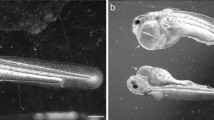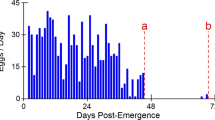Summary
-
1.
An investigation was carried out inDrosophila melanogasler to find out the effect of an unchanged chromosome II and changing the remaining chromosomes on the fecundity and hatchability. The stocks selected differed distinctly from each other in respect of both the traits. They were N-2 which was a normal wild type strain maintained in the laboratory and C-l containing a marked and completely balanced chromosome II obtained from outside.
-
2.
Reciprocal crosses were made between N-2 and G-l Hies. Selecting F-l females with the marked chromosome in one case, repeated backcrosses were made with N-2 males from stock and in another case with C-l males. In each generation, the fecundity and the hatchability were noted.
-
3.
Results showed that the chromosome II contained genes for fecundity and hatchability which were more than in all the other chromosomes put together.
Similar content being viewed by others
References
Berg, R. L. (1937). The relative frequency of mutations in different chromosomes ofDrosophila melanogaster, I. Lethal mutations, II. Sterility mutations.Genetics,22, 225–248.
Gowen, J. W. (1952).Heterosis. Iowa State College Press: Ames, Iowa.
Mazumdar, N. K. And Prabhu, S. S. (1969). Fecundity, egg-size and hatchability inDrosophila Melanogaster with a X-chroiriosome held unchanged.J. Genet.,60, 24–39.
Prabhu, S. S. (1960). Fundamental study of quantitative inheritance.Ann. Rep. Animal Genetics Division for 1959–60.
Prabhu, S. S., Negi, Swastika, andSingh, H. P. (1963). Quantitative studies ofDrosophila egg, I. Selection of medium.J. Anim. Morph. Physiol.,10, 31–46.
Prabhu, S. S., Singh, H. P., Prem Narayan And Negi, Swastika (1969). Analysis of 6x6 diallel cross for hatchability inDrosophila melanogaster.J. Genet.,60, 17–23.
Robertson, F. W. And Reeve, E. C. R. (1955). Studies in quantitative inheritance, VII. Crosses between strains of different body size inDrosophila melanogaster.Zeit. Abstamm.,86, 424–438.
Snedecor, G. W. (1959).Statistical Methods. The Iowa State College Press: Ames, Iowa.
Straus, F. S. (1942). The genetic mechanism of heterosis as demonstrated by egg production inDrosophila melanogaster.Ph.D. Thesis, Iowa State College Library: Ames, Iowa.
Author information
Authors and Affiliations
Rights and permissions
About this article
Cite this article
Tait, W.M., Prabhu, S.S. Fecundity and hatchability inDrosophila melanogaster with a second chromosome held unchanged. J Genet 60, 152–158 (1970). https://doi.org/10.1007/BF02984153
Issue Date:
DOI: https://doi.org/10.1007/BF02984153




